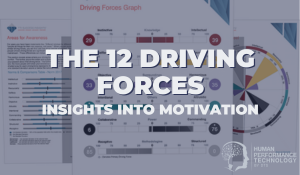Understanding Personal Drivers: A Key to Employee Motivation
What Are the 12 Driving Forces?
1. Knowledge & Learning Spectrum
- Intellectual - Driven by opportunities to learn, acquire knowledge and the discovery of truth.
- Instinctive - Driven by utilising past experiences, intuition and seeking specific knowledge when necessary.
2. Utility & Resources Spectrum:
- Resourceful - Driven by practical results, maximising both efficiency and ROI on time, talent, energy and resources.
- Selfless - Driven by completing tasks for the greater good, with little expectation of personal return.
3. Surroundings & Experience Spectrum:
- Harmonious - Driven by the experience, subjective viewpoints and balance in their surroundings.
- Objective - Driven by the functionality and objectivity of their surroundings.
4. Others & Service Spectrum:
- Altruistic - Driven to assist others for the satisfaction of being helpful or supportive.
- Intentional - Driven to assist others for a specific purpose, not just for the sake of being helpful or supportive.
5. Power & Individuality Spectrum:
- Commanding - Driven by status, recognition and control over personal freedom.
- Collaborative - Driven by being in a supporting role and contributing with little need for individual recognition.
6. Methodologies & Princples Spectrum:
- Receptive - Driven by new ideas, methods and opportunities that fall outside a defined system for living.
- Structured - Driven by traditional approaches, proven methods and a defined system for living.
Why Understanding Driving Forces Matters
- Tailored Motivation Strategies: People are motivated by different things. For some, it’s about knowledge and learning (Intellectual), while others might be more driven by achieving personal goals through leadership (Commanding) or contributing to a harmonious environment (Harmonious). Understanding these unique motivators allows talent professionals to craft strategies that resonate with each employee, leading to greater engagement and productivity.
- Improved Job Fit: Employees are more likely to thrive when their driving forces align with their role. For example, someone high in Resourceful will excel in a position that rewards efficiency and return on investment, such as sales or project management. Conversely, someone with strong Altruistic tendencies might feel more fulfilled in a role that allows them to help others, such as HR or customer service. Placing people in roles that match their motivators leads to higher job satisfaction and performance.
- Increased Engagement and Retention: When employees are placed in roles that align with their primary driving forces, they are more likely to feel engaged and connected to their work. This alignment reduces frustration and burnout, contributing to long-term retention. Employees are not only performing tasks they enjoy but are also being motivated by factors that are meaningful to them on a deeper level.
- Better Team Collaboration: Just as individual behaviour influences team dynamics, so do driving forces. By understanding the driving forces of team members, leaders can anticipate potential conflicts or areas of synergy. For example, a Commanding individual might clash with someone who is highly Collaborative. However, when these differences are recognised and appreciated, teams can balance leadership roles and create a more harmonious working environment.
- Guided Professional Development: Knowing an employee’s driving forces can help talent professionals design personalised development plans. For instance, an employee with a strong Intellectual drive may benefit from advanced training or opportunities to explore new topics, while someone motivated by Receptive methodologies may excel in roles that involve innovation and creativity. By catering development opportunities to these internal drivers, employees are more likely to stay engaged and committed to their growth.
Practical Applications for Talent Management
Customise Recognition and Rewards
Motivation isn’t one-size-fits-all. Customising recognition and rewards to match an employee’s intrinsic motivators leads to more meaningful and effective rewards. For example, someone with a Resourceful drive may appreciate bonuses or tangible incentives, while a Harmonious individual might value recognition that highlights how their contributions improved the work environment.
Improve Recruitment and Onboarding
Understanding driving forces during the hiring process allows talent professionals to place new hires in roles where they will thrive. During onboarding, providing insight into an employee’s driving forces can also help managers set expectations and create environments where new hires feel immediately engaged.
Foster Employee Empowerment
Empower employees by giving them autonomy in areas that align with their driving forces. For example, someone with a Commanding drive will flourish when given leadership responsibilities, while a Receptive individual might excel when given the freedom to explore new methods and ideas.
Develop Leadership Skills
For employees with leadership potential, understanding their driving forces can help them build leadership skills that resonate with their natural motivations. For example, a Collaborative leader might excel in team-based settings, whereas a Commanding leader might thrive in roles that require decisive action and individual leadership.

Trevor O'Sullivan
General Manager. Since the early 2000s, Trevor has worked with thousands of Talent Management professionals to develop and apply assessment-based talent management solutions for selecting, developing and managing people. Trevor is an active member of the TTI Success Insights (TTISI) Global Advisory Council, contributes to TTISI product development and is a regular presenter at TTISI-R3. He is honoured to have received multiple Blue Diamond Awards and, more recently, the Bill Brooks Impact Award recognising his contributions to the TTISI global network.


/Layers%20of%20performance%20overview.png?width=374&name=Layers%20of%20performance%20overview.png)
We Would Like to Hear From You (0 Comments)